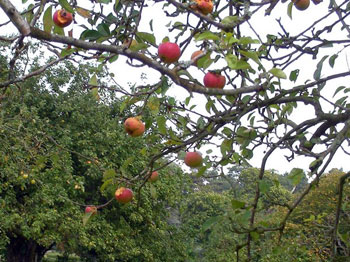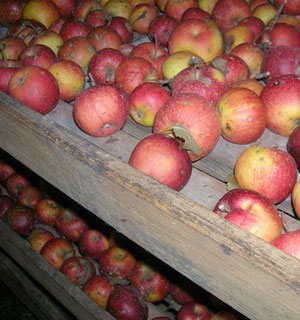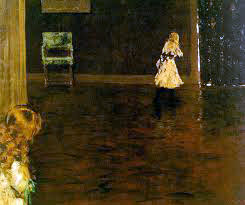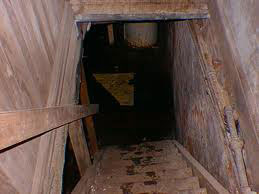 There are apples from a tree in Laurel Canyon that sit in a bowl on my hall table. The bowl, with its pie-crust edge comes from Rhinebeck, NY and reminds me of my son who's at school near there. The apples were pilfered by Miss Monica who defied the laws of gravity, heaving herself over the iron fence to find the tree in the grounds of the Houdini mansion, hidden by old rock walls that line this part of the canyon, white lilies and cactus.
There are apples from a tree in Laurel Canyon that sit in a bowl on my hall table. The bowl, with its pie-crust edge comes from Rhinebeck, NY and reminds me of my son who's at school near there. The apples were pilfered by Miss Monica who defied the laws of gravity, heaving herself over the iron fence to find the tree in the grounds of the Houdini mansion, hidden by old rock walls that line this part of the canyon, white lilies and cactus.
They are apples from another era, knobbled and imperfect and of an unsurpassed sweet:sour ratio, the kind Mrs. Beeton would have you pick for a Victorian apple crumble, the kind that grew in abundance in espaliered rows in the garden of the house I grew up in. Bordered with roses and Michaelmas daisies, in front of the rhubarb and the horseradish, the trees had been there for as long as I could remember, as as long as my father could remember before. Planted presumably by the Reverend John Wood who lived in the house with the crucifix windows with his two sisters.
The garden was an acre in size, maybe more if you include the lawn, laid out in four quadrants, apple trees down the center path, plum and cherry trees against the garden wall that bordered Readings field, a cold frame in the middle for lettuce and herbs, redcurrants and blackcurrants and gooseberries at three o'clock, near the old pigsties. Later, part of the garden was portioned off to raise guinea fowl, then pheasant and pea hens, and horses grazed there in the summer.
 It was a formal house, with a proper larder down a long hallway away from the kitchen, and a cellar, divided into three or four parts -- the apple room, the game room, the wine cellar -- almost as large as the whole of the kitchen, boot room, egg kitchen, wood room and play room combined. When autumn came around, the apple room was swept and fresh pink newspaper (the FT) spread out on the shelves where the apples were to be lain. Apples were carried in by the basketful, but only the unbruised ones kept for the winter. My brother and I helped, carefully picking our way down the stone staircase, the whitewashed brick, dodging hanging brace of birds, hare, even wood pigeon, holding our breath (my brother was tougher; I held mine). Rows of apples filled the room -- Bramleys, Pink Ladies, Discovery, Pearmain, Pippins, cooking and eating apples, three inches apart from each other, ready for winter.
It was a formal house, with a proper larder down a long hallway away from the kitchen, and a cellar, divided into three or four parts -- the apple room, the game room, the wine cellar -- almost as large as the whole of the kitchen, boot room, egg kitchen, wood room and play room combined. When autumn came around, the apple room was swept and fresh pink newspaper (the FT) spread out on the shelves where the apples were to be lain. Apples were carried in by the basketful, but only the unbruised ones kept for the winter. My brother and I helped, carefully picking our way down the stone staircase, the whitewashed brick, dodging hanging brace of birds, hare, even wood pigeon, holding our breath (my brother was tougher; I held mine). Rows of apples filled the room -- Bramleys, Pink Ladies, Discovery, Pearmain, Pippins, cooking and eating apples, three inches apart from each other, ready for winter.
One dry year -- probably 1976, the hottest summer on record in my short life -- the trees looked sickly and my father, a doer of the first order, took drastic action, cutting large swathes of bark from the trunk of each tree with his Norwegian fishing knife. He cut almost a full ring of bark, leaving just enough room for the sap to seep through. This way, he explained, the tree thinks it is dying and will produce a bumper crop of fruit. More fruit, he said, than you've ever seen. My brother and I helped water the trees with a hose. There was no rain that summer. And my father was right. There wasn't enough room in the cellar for the amount of apples that year.
 As all children know, a house with a cellar is the absolute best place for hide and seek. It was all our friends wanted to play when they came over for tea. After my mothers egg and tomato sandwiches (still my very favorite sandwiches in the world) and chocolate biscuits (and mini chocolate swiss rolls wrapped in silver paper), the game began. There were so many places to hide: the space under the staircase next to the stuffed leopard, the hall cupboard where my mother kept all her grandmother's fur coats -- a hiding place C.S. Lewis would have appreciated, the gun room with its lovely smells, under the boot table in the egg kitchen, the towel cupboard in my mother's bathroom, the secret balcony outside Mormor's window, the little housekeeper's bathroom by the larder, and then there was the cellar. Only when you were playing hide and seek you couldn't put the lights on.
As all children know, a house with a cellar is the absolute best place for hide and seek. It was all our friends wanted to play when they came over for tea. After my mothers egg and tomato sandwiches (still my very favorite sandwiches in the world) and chocolate biscuits (and mini chocolate swiss rolls wrapped in silver paper), the game began. There were so many places to hide: the space under the staircase next to the stuffed leopard, the hall cupboard where my mother kept all her grandmother's fur coats -- a hiding place C.S. Lewis would have appreciated, the gun room with its lovely smells, under the boot table in the egg kitchen, the towel cupboard in my mother's bathroom, the secret balcony outside Mormor's window, the little housekeeper's bathroom by the larder, and then there was the cellar. Only when you were playing hide and seek you couldn't put the lights on.
 My friend Pippa and I opened the bolt and lock on the heavy cellar door (the keys were kept in my father's desk, no doubt to prevent his wine from going missing). With our backs to the wall, we inched our way down the steps, our hands feeling their way on the dusty bricks, pushing cobwebs out of our faces, and hoping not to bump into a bloody, dead, rigamortized pheasant. Pippa managed to smother a scream with her hand. It was pitch black. All the sounds were muted by the sweet, stale air. "Just follow the apple smell" my 9-year old self whispered. There were three sets of seven steps, curving down to the left, and no handrail. We were groping in the dark. The scent of apples led us to our hiding place under some trestle tables. Rats were scuttling near us. We swore we could hear the flapping of bat wings. I hadn't even mentioned the ghosts...but my heart was pounding in my chest cavity. Pippa and I huddled together on the floor waiting to be found. We crouched silently, shivering a little, holding hands for comfort.
My friend Pippa and I opened the bolt and lock on the heavy cellar door (the keys were kept in my father's desk, no doubt to prevent his wine from going missing). With our backs to the wall, we inched our way down the steps, our hands feeling their way on the dusty bricks, pushing cobwebs out of our faces, and hoping not to bump into a bloody, dead, rigamortized pheasant. Pippa managed to smother a scream with her hand. It was pitch black. All the sounds were muted by the sweet, stale air. "Just follow the apple smell" my 9-year old self whispered. There were three sets of seven steps, curving down to the left, and no handrail. We were groping in the dark. The scent of apples led us to our hiding place under some trestle tables. Rats were scuttling near us. We swore we could hear the flapping of bat wings. I hadn't even mentioned the ghosts...but my heart was pounding in my chest cavity. Pippa and I huddled together on the floor waiting to be found. We crouched silently, shivering a little, holding hands for comfort.
"Scooby dooby doo" whispered Pippa.
Bumble Ward is a blogger and writer living in Los Angeles. She grew up with a Norwegian mother and an English father and spent every summer on an island in the Oslo fjord. www.misswhistle.com

